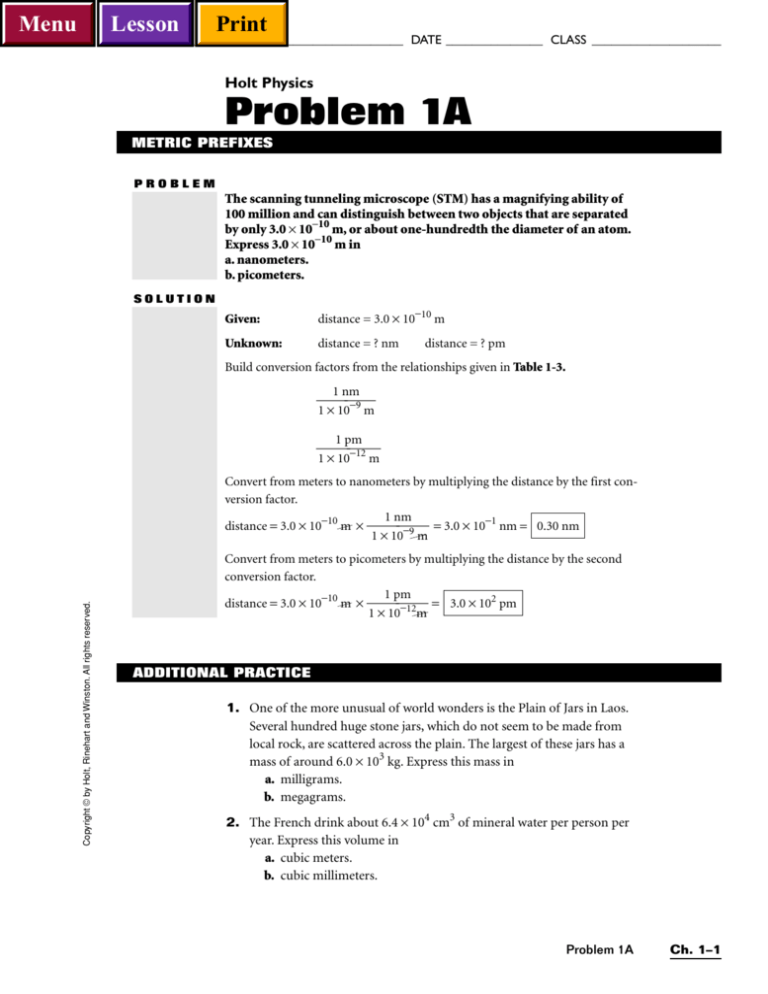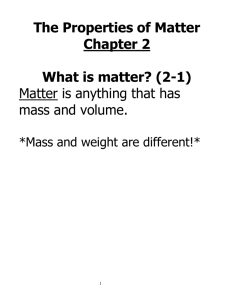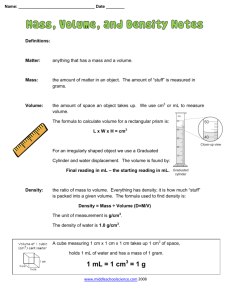
Menu
Lesson
Print
NAME ______________________________________ DATE _______________ CLASS ____________________
Holt Physics
Problem 1A
METRIC PREFIXES
PROBLEM
The scanning tunneling microscope (STM) has a magnifying ability of
100 million and can distinguish between two objects that are separated
by only 3.0 × 10−10 m, or about one-hundredth the diameter of an atom.
Express 3.0 × 10−10 m in
a. nanometers.
b. picometers.
SOLUTION
Given:
distance = 3.0 × 10−10 m
Unknown:
distance = ? nm
distance = ? pm
Build conversion factors from the relationships given in Table 1-3.
1 nm
1 × 10−9 m
1 pm
1 × 10−12 m
Copyright © by Holt, Rinehart and Winston. All rights reserved.
Convert from meters to nanometers by multiplying the distance by the first conversion factor.
1 nm
distance = 3.0 × 10−10 m ×
= 3.0 × 10−1 nm = 0.30 nm
1 × 10−9 m
Convert from meters to picometers by multiplying the distance by the second
conversion factor.
1 pm
distance = 3.0 × 10−10 m ×
= 3.0 × 102 pm
1 × 10−12m
ADDITIONAL PRACTICE
1. One of the more unusual of world wonders is the Plain of Jars in Laos.
Several hundred huge stone jars, which do not seem to be made from
local rock, are scattered across the plain. The largest of these jars has a
mass of around 6.0 × 103 kg. Express this mass in
a. milligrams.
b. megagrams.
2. The French drink about 6.4 × 104 cm3 of mineral water per person per
year. Express this volume in
a. cubic meters.
b. cubic millimeters.
Problem 1A
Ch. 1–1
Menu
Lesson
Print
NAME ______________________________________ DATE _______________ CLASS ____________________
3. The explosive energy of powerful explosives is measured in terms of
“tons.” The ton referred to is a ton of TNT (trinitrotoluene), one of the
most powerful of chemical explosives. A ton of TNT will release 4.2 ×
109 J (joules). Express this energy in
a. megajoules.
b. gigajoules.
4. A parsec, a distance measurement used by astronomers, is equal to
3.262 light years, where a light year is the distance light travels in one
year. In SI units, a parsec equals 3.086 × 1016 m. Express this distance in
a. kilometers.
b. exameters.
5. An acre is a common unit used to measure the area of a portion of
land. An acre is equal to about 4.0469 × 103 m2. Express this area in
a. square kilometers.
b. square centimeters.
6. Electric charge is measured in terms of the coulomb (1 C), although
this is a very large and not extremely practical unit of measurement.
For example, the charge in a bolt of lightning is about 15 C. Express the
charge in a lightning bolt in
a. millicoulombs.
b. kilocoulombs.
8. The United States Department of Defense is housed in the Pentagon,
one of the largest office buildings in the world. The entire floor area of
the Pentagon equals 0.344 279 km2. Express this area in
a. square meters.
b. square millimeters.
9. The Earth is approximately 4.50 billion years old. Setting 1 year equal
to 365.25 days, express the age of the Earth in
a. gigaseconds.
b. petaseconds.
10. One of the isotopes with the shortest half-life (the time it takes for half
of a sample of the element to decay) is beryllium-8. Its half life is measured as 6.7 × 10–17 s. Express this time in
a. microseconds.
b. attoseconds.
Ch. 1–2
Holt Physics Problem Bank
Copyright © by Holt, Rinehart and Winston. All rights reserved.
7. The wettest spot on Earth is generally considered to be Mt. Waialeale,
on the island of Kauai, Hawaii. In one year, this long-extinct volcano
receives 1.168 × 103 cm of rainfall. Express this quantity in
a. meters.
b. micrometers.
Menu
Lesson
Print
The Science of Physics
Chapter
1
Additional Practice 1A
Givens
1. mass = 6.0 × 103 kg
Solutions
103 g 1 mg
a. mass = 6.0 × 103 kg × × −3
= 6.0 × 109 mg
1 kg 10 g
103 g 1 Mg
b. mass = 6.0 × 103 kg × × 6 = 6.0 Mg
1 kg 10 g
2. Volume = 6.4 × 104 cm3
1m
a. volume = 6.4 × 104 cm3 × 2
10 cm
3
1 m3
= 6.4 × 10−2 m3
= 6.4 × 104 cm3 ×
106 cm3
10 mm
b. volume = 6.4 × 104 cm3 ×
1 cm
3
103 mm3
= 6.4 × 104 cm3 ×
= 6.4 = 107 mm3
1 cm3
3. energy = 4.2 × 109 J
1 MJ
a. energy = 4.2 × 109 J ×
= 4.2 × 103 MJ
106 J
1 GJ
b. energy = 4.2 × 109 J ×
= 4.2 GJ
109 J
4. distance = 1 parsec
= 3.086 × 1016 m
1 km
a. distance = 1 parsec = 3.086 × 1016 m × 3 = 3.086 × 1013 km
10 m
1 Em
b. distance = 1 parsec = 3.086 × 1016 m × 18 = 3.086 × 10–2 Em
10 m
5. area = 1 acre
= 4.0469 × 103 m2
1 km
a. area = 1 acre = 4.0469 × 103 m2 × 3
10 m
2
1 km2
area = 4.0469 × 103 m2 × 6 2 = 4.0469 × 10−3 km2
10 m
102 cm
b. area = 1 acre = 4.0469 × 103 m2 ×
1m
2
104 cm2
area = 4.0469 × 103 m2 ×
= 4.0469 × 107 cm2
1 m2
6. electric charge = 15 C
103 mC
a. electric charge = 15 C × = 1.5 × 104 mC
1C
1 kC
b. electric charge = 15 C × 3 = 1.5 × 10–2 kC
10 C
Section Two—Problem Workbook Solutions
V
V Ch. 1–1
Menu
Lesson
Print
Givens
Solutions
7. depth = 1.168 × 103 cm
1m
a. depth = 1.168 × 103 cm × 2 = 1.168 × 101 m = 11.68 m
10 cm
1 mm
1m
b. depth = 1.168 × 103 cm × 2 × −6 = 1.168 × 107 mm
10 cm 10 m
8. area = 0.344 279 km2
103 m
a. area = 0.344 279 km2 ×
1 km
2
103 m
b. area = 0.344 279 km2 ×
1 km
2
= 0.344 279 × 106 m2 = 3.442 79 × 105 m3
103 mm
×
1m
2
= 0.344 279 × 1012 mm2
area = 3.442 79 × 1011 mm2
9. time = 4.50 × 109 years ×
365.25 days 24 h 3600 s
× ×
1 year
1 day
1h
17
= 1.42 × 10 s
10. time = 6.7 × 10−17 s
1 Gs
= 1.42 × 108 Gs
a. time = 1.42 × 1017 s ×
109 s
1 Ps
b. time = 1.42 × 1017 s × 1
= 1.42 × 102 Ps = 142 Ps
10 5 s
106 ms
a. time = 6.7 × 10−17 s × = 6.7 × 10−11 ms
1s
Copyright © Holt, Rinehart and Winston. All rights reserved.
1018 as
b. time = 6.7 × 10−17 s × = 6.7 = 101 as = 67 as
1s
V
V Ch. 1–2
Holt Physics Solution Manual







